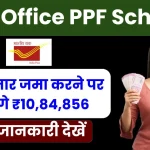
The Public Provident Fund (PPF) is one of the most popular long-term savings schemes in India, offering tax-free returns and a secure investment option for individuals. The PPF extension rules allow investors to continue their accounts beyond the initial 15-year maturity, which can be a strategic move for regular income generation. This article explains how you can extend your PPF account, maximize benefits, and use it as a reliable source of steady income.
PPF Extend Rules
| Feature | Details |
|---|---|
| PPF Maturity Period | 15 years, extendable in 5-year blocks |
| Extension Without Contribution | Allowed; balance earns interest; unlimited yearly withdrawals |
| Extension With Contribution | Allowed by submitting Form 4; limited withdrawals (max 60% of balance over 5 years) |
| Interest Rate | Set quarterly by the government |
| Tax Benefits | Tax-free returns under Section 80C |
| Best Use for Regular Income | Withdraw funds annually after extension to supplement earnings |
The PPF extension rules provide an excellent way to grow your savings while ensuring a steady income. By choosing the right withdrawal strategy, you can maximize your returns and plan for a secure financial future. Whether you’re a retiree looking for tax-free income or a young investor planning long-term wealth creation, PPF remains a powerful financial tool.
Understanding PPF Maturity and Extension Rules
A PPF account matures after 15 years from the date of opening. Upon maturity, the account holder has three options:
1. Withdraw the Entire PPF Balance
- If you don’t need further tax-free returns, you can withdraw the full amount and close the account.
2. Extend PPF Without Further Contributions (Default Option)
- If no action is taken within one year of maturity, the account automatically extends for another 5-year block.
- No additional deposits are allowed, but the entire balance continues earning interest at prevailing rates.
- Withdrawals: One withdrawal per financial year, with no upper limit.
3. Extend PPF With Contributions (Requires Form 4 Submission)
- If you want to continue contributing, submit Form 4 within one year of maturity.
- Continue investing up to ₹1.5 lakh per year.
- Withdrawals: Allowed, but with restrictions. Over the 5-year extension, the total withdrawals cannot exceed 60% of the balance at the start of the extension.
see also: How to Save Money Smartly
How to Use PPF for Regular Income
1. Withdraw Without Contributions (Best for Retirement Income)
- If you have a substantial balance, extending without contributions allows yearly withdrawals without limit.
- Example: If your balance is ₹40 lakh, you can withdraw ₹4-5 lakh per year while still earning interest.
2. Withdraw With Contributions (Best for Growing Corpus While Taking Some Income)
- With this approach, interest continues accumulating, and you can withdraw up to 60% of the balance over 5 years.
- Example: If your balance is ₹20 lakh, you can withdraw ₹12 lakh total over 5 years (~₹2.4 lakh per year).
3. Ladder PPF Withdrawals for Steady Cash Flow
- Extend in multiple 5-year blocks to ensure continuous availability of funds.
- Example: Instead of withdrawing a lump sum at once, withdraw only the interest earned each year.
4. Use PPF for Retirement Planning
- Combine PPF with other income sources like mutual funds, pension plans, and fixed deposits.
- A good strategy is to withdraw only the required amount while letting the remaining balance grow tax-free.
see also: Post Office Special Savings Scheme Earn ₹7,24,974
PPF Extend Rules FAQs
1. Can I extend my PPF account multiple times?
Yes, PPF can be extended indefinitely in 5-year blocks.
2. What happens if I don’t submit Form 4 for extension?
Your PPF will be extended automatically, but without further contributions.
3. Is the interest earned during the extension period taxable?
No, all interest earned on PPF remains tax-free.
4. Can I close my extended PPF account early?
PPF cannot be closed before completing each 5-year extension period, except in rare cases like medical emergencies.
5. How much interest will I earn on my PPF balance?
The PPF interest rate is revised quarterly by the government.











